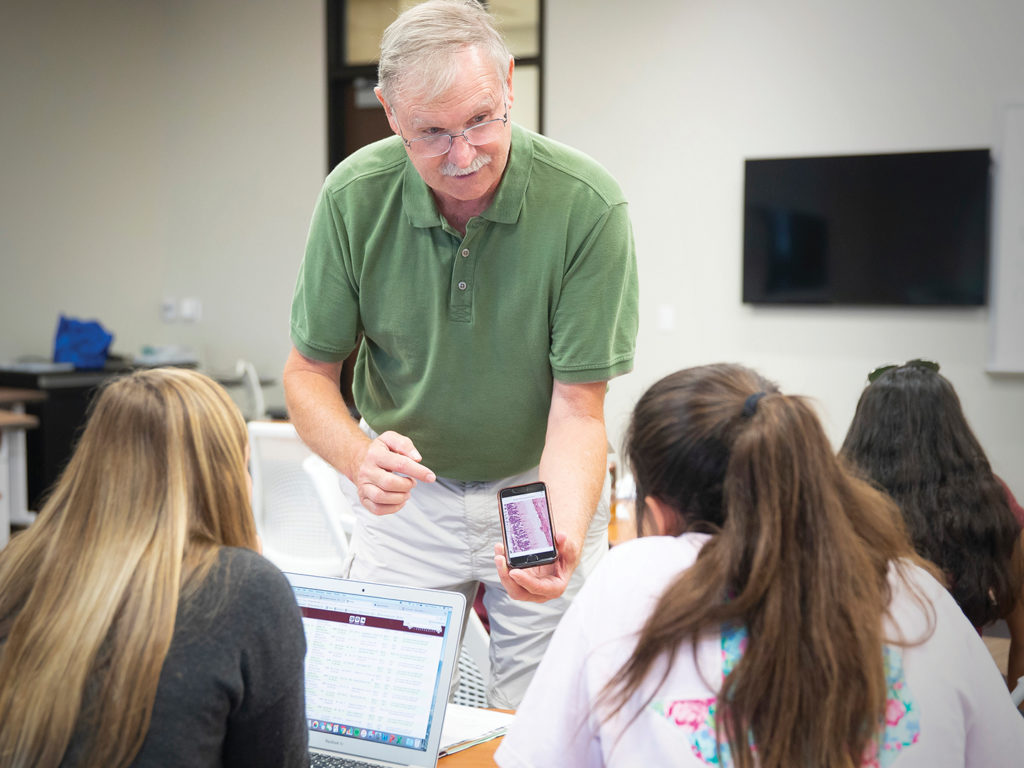CVMBS Teaching Assistants Support Undergraduates Learning Histology
Story by Jubilation Brown and Dr. Larry Johnson

In Dr. Larry Johnson’s VIBS 243 course on histology at the Texas A&M College of Veterinary Medicine & Biomedical Sciences (CVMBS), teaching assistants (TAs) play an invaluable role in mentoring and teaching undergraduate biomedical sciences (BIMS) students. Over the past several years, these BIMS students have expressed great appreciation for the TAs’ efforts.
Each semester, 15 to 24 undergraduate students gain experiential learning in mentoring, teaching, communication, and organization by serving as TAs.
TAs coordinate, run, and take attendance for the course’s help desk three days a week; assist students with their clinical correlation video presentations; support histology course mastery and student development; provide instruction; and, most of all, extrude a love for histology and STEM learning. The pre-professional student TAs also serve as role models by creating a picture of what’s possible and making it easy for others to follow.
Many BIMS students have expressed their gratitude and appreciation for their undergraduate TAs during the VIBS 243 end of course evaluation. Students were able to type out personal responses in an anonymous course evaluation and the vast majority offered their praises.
Many students felt that the TAs helped them succeed in the course, saying they “appreciate the way TAs explain things on a more overarching/conceptual scale,” allowing them to “more easily see the inter-connectivity of everything.”
Students found it helpful that TAs “used real life examples and really emphasized important information,” as well as how they “would really break down topics and find ways to make connections between different systems,” making content “easier to understand and remember.”
Students also felt that the passion and dedication of the TAs was a large help to their success, with one students saying the TAs’ “dedication to our success in the class was so evident and made me enjoy the class so much more.”
They appreciated that the TAs “really cared if they understood the material” and showed “genuine interest in what was being taught” and how that translated into being “a more effective teacher.”
The TAs were also praised for their role of supporting students during such a troubling time, with one student commenting, “Going into this class, I felt very overwhelmed, but my TA made my learning experience so much easier to understand and I cannot thank the TA enough for that.”
Students also expressed that the TAs were invaluable for not only “supporting us in our studies but also our mental well-being,” and expressing their gratitude for the way the TAs were “truly invested in our success” and “always ready and eager to answer questions.”
While this information was pulled from more than 200 student course evaluations in the fall of 2020, VIBS 243 has been taught for 4 sections in fall and 2 sections in spring semesters for several years with similar comments about the TAs.
By encouraging, supporting, and helping students through complex topics and difficult times, the TAs of the VIBS 243 histology course were able to make a lasting impact on those around them while developing invaluable life skills. With far more words of praise and appreciation than can be mentioned, it is clear how effective these teaching assistants are at improving the learning experience and environment of VIBS 243 students.
Jubilation Brown is a second-year veterinary student and a BIMS graduate. She has served as a TA in VIBS 243 for 5 years, reorganized the course on eCampus, and has coordinated other TAs for 4 years. She has produced and posted videos for 12 quiz reviews as well as midterm and final reviews each semester and recently converted the course from eCampus to Canvas.
Dr. Larry Johnson is a professor in the Texas A&M College of Veterinary Medicine & Biomedical Sciences’ (CVMBS) Department of Veterinary Integrative Biosciences (VIBS) and serves as the director of the college’s PEER (Partnerships for Environmental Education and Rural Health) program.
###
For more information about the Texas A&M College of Veterinary Medicine & Biomedical Sciences, please visit our website at vetmed.tamu.edu or join us on Facebook, Instagram, and Twitter.
Contact Information: Jennifer Gauntt, Director of CVMBS Communications, Texas A&M College of Veterinary Medicine & Biomedical Sciences; jgauntt@cvm.tamu.edu; 979-862-4216


